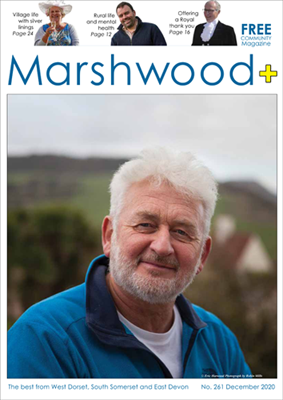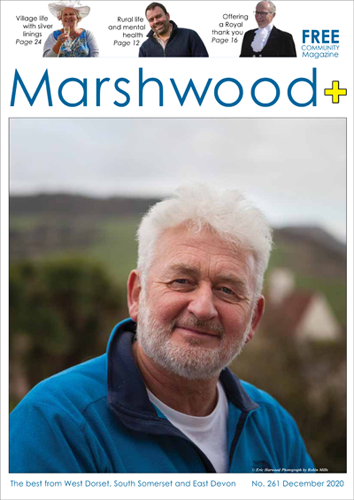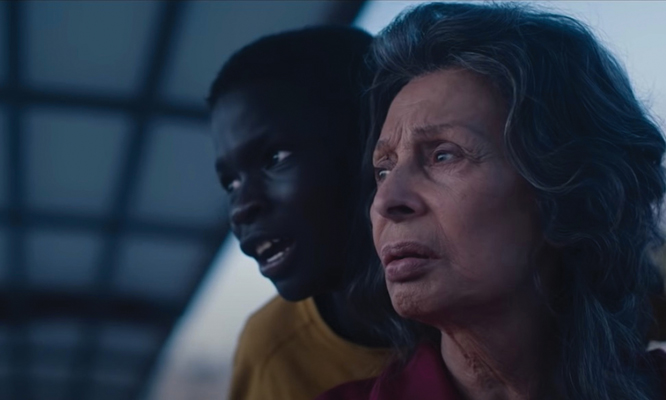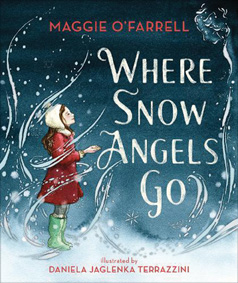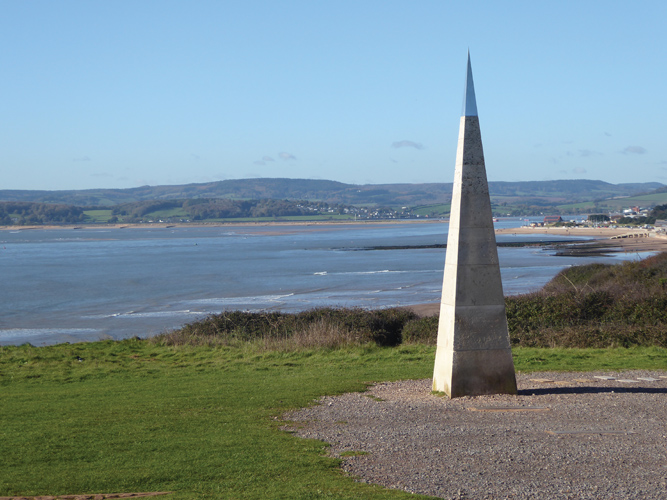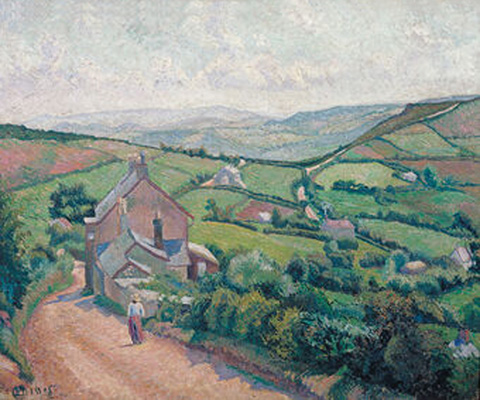Interviewed by Seth Dellow
Lifting Spirits
With the potential for a less sociable Christmas than last year,
East Devon author Bruce Harris has a few suggestions to lift your mood.
Many people are likely to be finding this Christmas quieter than most, with less hospitality both offered and taken. One of the few upsides will be an increase in ‘me time’; and those who dedicate some of their me time to reading will perhaps be unusually well off during this festive season.
Some people, of course, tend to read within the same genre, venturing only rarely out of their comfort zone. Fortunately, this country produces vast quantities of books in all genres to cater for those staying where they’re happy as well as anyone daring enough to take a Yuletide walk on the wild side.
None of the books mentioned is new; it usually takes a book at least weeks, and sometimes years, to make an impact. But they are all books I have read and enjoyed recently and they are all widely available, so any of them could conceivably unlock treasure troves of new reading to open-minded readers.
The Funny One
The Road to Little Dribbling
by Bill Bryson
Published Transworld Publishers 2016
Paperback RRP £9.99
Twenty years after Bill Bryson’s resounding success with Notes from a Small Island, he has British as well as American citizenship and a British wife and family. Curious to know ‘what’s the furthest you can travel in a straight line without crossing salt water’, his ruler indicates a line from Bognor Regis in the south to a Scottish promontory called Cape Wrath.
His journey along this line forms the structure for this book, but of course, the real subject of the book, like most other Brysons, is Bryson himself. His reactions to the places he visits and the experiences he has are sometimes caustic and incredulous, but more often than not, very funny.
Observations on the area where the reader lives are perhaps going to be most carefully read, and Bryson travels extensively in the West Country, through Dorset, Devon and Cornwall. He passes through Lyme Regis with a pleasant nod to the history of Mary Anning and her dedication to fossils: ‘the house where she lived is now the site of the local museum, and it is, let me say at once, a perfect little institution’.
A word of warning, however, in case you’re thinking of presenting a copy to your favourite aunt. Bryson’s humour and language can be muscular. Any strong language is entirely in context and contributes to the humour, but there are quite frequent instances of it.
However, readers who can live with the muscular and are interested in a subjective, honest and sometimes very funny comparison between Britain in the nineteen-nineties and Britain in the twenty-teens will get an absorbing festive read from this book.
The True one
The Spy and the Traitor
by Ben Macintyre
Published Viking 2018
Paperback RRP £8.99
Ben Macintyre, who is extremely good at books like this, has chartered in detail the extraordinary achievement of MI6 in getting their top agent at the time, Colonel Oleg Gordievsky, away from KGB interrogation and out of Russia altogether in 1985. With his typically meticulous research, Macintyre tracks the process by which Gordievsky, a remarkably intelligent and cultured man, becomes a double agent. Colonel Gordievsky has managed to place himself in charge of Russian secret service activities in Britain. When the Kremlin finally smells a rat and summons him back for lengthy interrogation intended to wear him down, an MI6 team gets him out of Russia and into Finland in a car boot, and thereafter, more comfortably, back to Britain.
Gordievsky’s immense contribution, which is in some ways directly responsible for the détente between Reagan and Gorbachev, is also made clear, as is the price he paid for it in his matrimonial and family life. It is the kind of book which, once picked up, is very difficult to put down.
The Autobiographical One
Unreliable Memoirs
by Clive James
First Published Picador 1981
Re-published as Picador Classic 2015
RRP Paperback £9.99
Clive James, who died almost exactly a year ago, became something of a national institution via his writing and broadcasting and wrote several autobiographical books along the way. The difference with this one is that it deals with his Australian years, from his date of birth to his early twenties, when he emigrated to the U.K.
As one might expect, it is often screamingly funny, but also predictably, analytic both of himself and the world around him. The childhood and youth stages of autobiographies are sometimes people’s least favourite bits of them and sometimes rather skirted over, but James, unlike some, is not out to acquit himself or talk up the genius he became. He is self-effacing, but hilariously so, and so eloquently descriptive of Australia in the 1920s and 1930s as to make this very foreign environment come alive in his readers’ minds. At 184 pages, it is not a forbidding tome and it handsomely rewards those who take the trouble to read it.
The Intellectual one
Machines Like Me
by Ian McEwan
Published Vintage 2019
Paperback RRP £8.99
Ian McEwan is one of the leading novelists of his time, and many of his books have been turned into films or TV series, including First Love, Last Rites, The Cement Garden, The Innocent, Enduring Love, Atonement, On Chesil Beach, Solar and The Children Act.
Machines Like Me might well follow them. Set in an alternative nineteen-eighties, Mrs. Thatcher loses the Falklands War and the subsequent election sweeps Tony Benn to power in a landslide. Sir Alan Turing of Bletchley Park fame lives with a long term gay partner and has made been the major instigator in the development of a first batch of synthetic humans, all the males called Adams and all the females called Eves.
Charlie, a drifter and amateur stock market trader, blows a substantial inheritance on buying one of the Adams, the females being out of his price range.
For a lesser writer, this could have turned into ‘McEwan does Frankenstein’ or ‘Labour Party Historical Wishlist’. But, of course, McEwan does much better than that; he makes this bizarre world credible, even commonplace, and the relationship between Charlie and Adam as they eat into each other’s lives and those of others around them brings up questions and comparisons concerning the human condition which cannot fail to provoke thought in the reader, while carefully not providing easy answers or conclusions.
It is absorbing, and at times funny—McEwan is never humourless—and rather than go in for any sci-fi stock in trade ‘parallel universes’, it creates an entirely believable, if challenging and problematic, world to inhabit and ask questions about.
Happy reading and happy Christmas!
Screen Time December 2020
This month I have decided to journey back in time to some of the golden oldies of UK and US television
Amazon Prime
Twin Peaks
During Lockdown 1 we decided, as a family, to watch all 48 episodes of David Lynch’s classic. It was a revelation not only for how entertaining it was, but I realised, I had forgotten so much of the plot and the strange obsessions of the director and his co-writer Mark Frost. F.B.I. Special Agent Dale Cooper is one of the most enjoyable and inspiring characters in television history. His simple passions and quirky behaviour was a welcomed sight in our living rooms every week during the shows very short run in the late 80’s and early 90’s. “Twin Peaks” started out on fire, gaining exposure during the pilot’s multiple airings. The mystery of Laura Palmer’s murderer practically invented conversations at the water cooler.
Jewel in The Crown
“There’s nothing we can do,” says one character at the end. “After 300 years of India, we’ve made this whole damned, bloody, senseless mess.”
The actors are all excellent, but Tim Piggott Smith as Ronald Merrick is quite extraordinary, a character who is both disturbing and strangely pitiable.
“Saturated in gin fizz and repressed emotion, The Jewel in the Crown sits alongside Brideshead Revisited as the high-water mark of 1980s British TV. Understated and hugely poignant, its 14 episodes trace the decline of the British Raj”
Alexandra Coghlan, The Guardian .
Netflix
The Thick of It
24 episodes worth of satire on the lack of competence of British politicians! Peter Capaldi’s character Malcolm Tucker has all the best lines peppered with many expletives.
More recent series that have caught my eye on Netflix
Call My Agent
A French series where in every episode a famous French star plays themselves as a client of the agency. Endlessly entertaining melodramatic French farce set in Paris.
Emily in Paris
This is Paris through the eyes of a young American on her first ever visit. The series creator is Darren Star who created Sex and The City. Emily’s main adversary Sylvie Grateau is played by Phillipine Leroy-Beaulieu who is also a key player in Call My Agent. However, opinions are divided on this series:
“None of the same praise can be levelled toward Star’s newest effort, “Emily in Paris.” All of the criticisms that have previously been levelled at Star are actually valid when it comes to the Netflix series, which is so devoid of narrative tension that it barely qualifies as entertainment.” Roxana Hadadi Roger Ebert.com
“Yes, Emily In Paris is unrealistic. But when it comes to escapist TV, reality is overrated”
Hadley Freeman. The Guardian.
All 4
The West Wing
If like me, you were glued to the US election there are 155 episodes about the presidency of Josiah “Jed” Bartlett, a Democrat. Created by Aaron Sorkin one of the great storytellers of US television, The West Wing won 26 Emmy’s including Outstanding Drama Series which it won four consecutive times from 2000-2003.
“at heart The West Wing was a civic romance in love with democracy, and it didn’t care who knew it.” Time Magazine rated it one of the best series of all time.
And Finally.
Netflix premieres a film starring Sophia Loren. One of the great stars of Cinema. Winner of an Oscar in 1962 (“La ciociara”), nominated for another Oscar in 1965 (“Matrimonio all’italiana”) and now 56 years later is tipped to be nominated for The Life Ahead (La vita davanti a sé)
“Sophia Loren, 86, returns to the screen after a decade to play a Holocaust survivor who raises the children of prostitutes. There is not a single false note in Loren’s magnificent performance. Just sit back and behold.” Peter Travers ABC.
Young Lit Fix December 2020
Picture Book Review
Where Snow Angel’s Go
by Maggie O’Farrell,
Illustrated by Daniela Jaglenka Terrazzini
Walker Books, RRP £14.99
Ages 5+
Reviewed by Antonia Squire
“Have you ever woken suddenly, in the middle of the night, without knowing why?
Once, and not too long ago, this happened to a girl.”
Sylvie awakens in the middle of the night to see a strange, icy but beautiful figure in her room muttering to himself. He’s as surprised as she is by this turn of events, she’s not supposed to be able to see him, he’s supposed to be invisible.
He is her Snow Angel, there to protect her from harm, only present when he is truly needed. Sylvie is quite unwell for quite some time, and she certainly isn’t supposed to remember his visit, but she doesn’t forget. When she recovers, she tries everything she can to get him to return.
A gloriously illustrated, magical tale of love and kindness perfect for Christmas and other winter festivals. A perfect addition to any family library, and a new holiday tradition.
Middle Grade Review
A Girl Called Owl
by Amy Wilson
Pan Macmillan, RRP £6.99
Ages 9+
Reviewed by Nicky Mathewson
Being given the name Owl can be problematic for a child who wishes to blend in, but her mother saw magic in her and knew she was unique. Soon Owl would discover that she could never fit in, not completely. How could she, when she was the daughter of Jack Frost.
Desperate to know who her father is, Owl pesters her mother until she finally admits the truth. But how can such a thing be true? The stories her mother told her as a small child were fantasy, bedtime stories: Fairies, The Green Man, Mother Earth, Jack Frost, they’re not real…are they?
As Autumn is coming to an end, Owl starts to change, frost starts to creep over her skin. She needs to understand what is happening to her, and soon, before others notice and it gets out of control. She needs to find her father, and really know who she is, but Jack Frost is an element of nature that cannot be tamed. He is dangerous, powerful and cruel.
This is the most magical winter’s tale of self-discovery, friendship, family bonds and a fight for power. I adored Amy Wilson’s world building which shifts between the human world and the land of The Fay. Owl, who is a wonderful strong female lead, comes to depend on her friends in matters of life and death and admit that she needs help.
This gorgeous middle grade book is full of danger, with twists and turns aplenty. Taking us with an icy grip through a wintery landscape, whilst warming our hearts completely. I loved it.
Teen Review
One of Us is Lying
by Karen M. McManus
Penguin Books, RRP £7.99
Ages 14+
Reviewed by Antonia Squire
When I was a teenager (and I’m showing my age here) The Breakfast Club was one of my favourite films, so when this book landed on my desk, saying “Five Students walk into detention. Only four leave.” I was all – Dude, it’s The Breakfast Club with Murder!
One of Us is Lying is an awesome murder mystery set around the brutal gossip culture of an American high school. Replete with anonymous social media postings, suspicion, intense local television coverage and a police force convinced that one of the four remaining kids is guilty and will stop at nothing to prove it. Four very different students, from four very different groups find themselves in a very grown up situation and only together can they figure out what actually happened. Because it becomes very clear that if they don’t, no one else will.
A taut, smart, compelling thriller where nothing is clear, no one is telling the truth, and secrets abound. It’s fantastic!
10% off RRP exclusively for Marshwood Vale Magazine Readers
at The Bookshop, Bridport
Behind the Mask
When I was eight, my favourite item of clothing was my ‘Zorro’ mask. Simple, black and elegant, I wouldn’t go anywhere without it. Kids’ parties, walking the dog, playing in the garden or even going to bed—on went my mask and, in a flash, I was the bravest and finest swordsman on the planet and invisible to all the baddies! We’ve got masked heroes like Batman, Spiderman and the Lone Ranger and tortured masked villains like the Joker, Darth Vader, Phantom of the Opera and Hannibal Lecter, although the latter’s mask was to stop him from eating other people rather than conceal his identity!
Masks can hide you or protect you from other people, or they can protect others from you and any germs you might be harbouring. In just a few months, we have now got so used to masks that it’s become completely normal to carry them wherever you go. I pop them on and off in shops or public places without a second thought. Yes, they’re a bit of a bore and an inconvenience, but they are now a part of day-to-day life and likely to be with us for many years to come—if not in perpetuity.
So, rather than grudgingly put up with them, I feel we should embrace them joyfully and use them to our advantage. For a start, face masks are a major new item of fashion and the biggest impact to boring old clothes for decades. I’ve seen skeleton masks, smiley face, floral, cat and wild animal masks. And they don’t have to be boring old light blue. Be inventive and go for colourful art or a meaningful message which has much more impact than lacklustre phrases on a T-shirt. Text on a mask is literally “in your face”, or more correctly perhaps “on your face”. My current favourites are “If you can read this, you’re too close to me”, “Quarantine Queen” and a plain black one with “This is my happy face mask”.
One potential problem is how wearing a mask makes us all more remote from each other as human beings. It’s impossible to be 100% sure of anyone’s facial expression. Is he smiling or is it a frown? Is she being friendly or disgusted? I know that the eyes are supposed to tell us most things about a person, but it doesn’t work in practice. Seeing your eyes but not your nose or mouth conveys only part of the message where a pout can easily become half a grin. Perhaps we need hand signals as extra clues? Four fingers held up together means ‘I really am smiling, please smile back’. A clenched fist might mean ‘please go away’—a bit like pictorial emojis added to a mobile text message.
Another problem is the failure to recognise people. You’re in the supermarket and everyone’s got a mask on. A couple bump into you near the frozen fish section and they both turn their faces to you and say ‘Hello!’. Who on earth are these people? They obviously know me but they might be that nice couple from number 27 or the new Honiton bank manager and her husband. I have no idea… and because I don’t immediately respond, they walk on and will forever think I’m the rudest person in Devon.
This problem can be used to your advantage in reverse. You know how putting on a mask makes you strangely invisible to others, just like me putting on my Zorro mask? Well, for the first time in your life you can be extremely rude to people you don’t like when you’re wearing a mask. You can silently mouth all kinds of obscenities at them and pull rude faces but they will not know. They will probably think you’re smiling at them and say ‘Good Morning’ to you. This is strangely satisfying and exciting! Just make absolutely sure your mask fully covers your mouth!
You could even go one stage further if you are brave enough. Try walking into a shop with absolutely no clothes on except for your mask. Apart from causing considerable offence and an affront to public decency (and possibly getting arrested), you’ll be OK because nobody will know who you are. I’m not really promoting this idea as it is fraught with danger. And please wear a boringly common light blue mask as somebody might recognise you if you wear your individual pirate disguise or President Trump mask. You could also anonymously rob a bank I suppose, but I am not encouraging this either!
There are plenty of advantages to wearing a mask. Women never need to put on lipstick. Men can hide their embarrassing designer stubble. Acne, spots and zits are never visible. The material will also partially disguise morning ‘bad beer breath’ and nobody will ever annoy you again by saying ‘why aren’t you smiling?’ as they’ll have no idea if you are or you aren’t. The only other downside is that talking through material smothers your speech like cotton wool, but then since I am increasingly deaf, I’m already asking everyone to repeat what they just said.
But perhaps the best thing about wearing a mask is the wonderful new sensation of liberation. You know… you’ve been out shopping with your mask and finally get back half-suffocated to your car. You close the door and remove your mask. The feeling of utter relief at being able to breathe again is fantastic!
Hercule Poirot’s Christmas
I am sure he would have joined me in wishing you a very Happy Christmas.
Agatha Christie wrote a novel entitled Hercule Poirot’s Christmas, produced in 1938, but this article is about her first published novel, published 100 years ago this year, in September 1920. It was entitled The Mysterious Affair at Styles and was our first introduction to Hercule Poirot, Captain Arthur Hastings and Detective Inspector James Japp of Scotland Yard. Miss Lemon is not included in this book.
In 1919 Agatha Christie met John Lane of Bodley Head Publishers about her novel. He suggested a certain amount of rewriting, which she carried out and Bodley Head gave her a contract dated 1st January 1920 for six books. The novel was serialised in The Weekly Times in February 1920 and began sale as a book on 21st January 1921.
In the story, Hastings has been invalided home from the Front and given a month’s sick leave. He met John Cavendish, an old friend who invited him to spend his leave at his family home, Styles Court. There Hastings collided with his old Belgian friend Poirot, who was staying with some Belgian refugees. Poirot was described as a little man, no more than five feet four inches, with an egg-shaped head and a very stiff and military moustache. Hastings said that Poirot had been one of the most celebrated of the Belgian police and had inspired Hastings to follow his methods.
Soon after this meeting, Mrs Emily Inglethorp was murdered. She was about 70 years old and had recently married Alfred Inglethorp some 20 years younger. Emily had earlier married Mr Cavendish, a widower with two small sons and she brought them up when Mr Cavendish died.
I made a list of the participants to assist my following of the narrative, as follows:
John Cavendish, aged 45, a barrister now looking after the Styles estate, adopted son of Mrs Inglethorp, married to Mary, who works on the land. Lawrence Cavendish, younger brother of John, qualified as a doctor, unmarried and unemployed. Evelyn Howard, 2nd cousin of Alfred Inglethorp, aged about 40, a nurse. Cynthia Murdoch, works as a VAD in nearby Hospital Dispensary, a ward of Emily Inglethorp. Dr Bauerstein, a poison expert, lives in the village as does Mrs Raikes, an attractive wife of a local farmer. Several housemaids/cook and two gardeners. Enough for Poirot to consider and Hastings to puzzle over.
I will not spoil any more of the story, but like so many of Agatha Christie’s stories, it is very convoluted. Enjoy it by obtaining the book or watching it on television.
Since publication of The Mysterious Affair at Styles, Agatha Christie wrote some 37 books featuring Hercule Poirot, plus two plays and a number of compilations of short stories. Later she introduced an elderly spinster, Miss Marple in about 14 books plus short stories, in which she ‘assists’ the police to reach a conclusion. The Murder at the Vicarage was the first Marple. Soon after the introduction of Poirot and Marple they were both performed on stage, film and then television.
Actors performing as Poirot have included, the first on stage, Charles Laughton, films have included Austin Trevor (1931), Peter Ustinov (3 films), Albert Finney, David Suchet, Kenneth Branagh. Miss Marple has been played by Margaret Rutherford, Angela Lansbury, Geraldine McEwan, Joan Hickson and Julia McKenzie, among others. I once advised an elderly lady that Miss Marple was on TV that day and she scathingly replied ‘But not the Proper Miss Marple’. Perhaps she remembered Margaret Rutherford.
But with so many television appearances from 1989 David Suchet, has surely become the Hercule Poirot we all think of, supported by Hugh Fraser as Captain Arthur Hastings and Philip Jackson as Chief Inspector James Japp. And of course, although not in The Mysterious Affair at Styles, Pauline Moran as Miss Felicity Lemon, and Zoe Wanamaker and Julia McKenzie as Ariadne Oliver.
Agatha Christie was born in Torquay, Devon on 15th September 1890. She was the last of three children, the eldest being her sister, Margaret and the middle child, her brother, Louis Montant. Her father, Frederick Miller was American and her mother, Clarissa Boehmer, was born in Ireland. Her father had inherited wealth and was nominally a stockbroker. He died in 1901. Agatha had little formal education, apart from her parents and ‘Nannie’. Probably the latter taught her to read. Later she had two days a week with a local teacher and dancing lessons. She was very close to her mother and loved their home. Agatha had two years in Paris and a season in Cairo.
In 1914 she met Archibald Christie, who was training to be a pilot in the RFC while she had become a VAD in the local hospital, where she probably learned about poisons. They were married on Christmas Eve 1914. He was transferred to the Artillery and became a Captain. They had a daughter, Rosalind in 1919. Archibald was promoted to Colonel and went to work in the City.
Agatha had already written stories and poems, but her sister challenged her to write a detective story and The Mysterious Affair at Styles was the result. Archibald read it and liked it, so she tried several publishers until Bodley Head took it up, as mentioned earlier.
In April 1926 Agatha’s mother, Clarissa, died and Archie announced that he wanted a divorce. These two events probably caused Agatha to run away to Harrogate for a couple of weeks, leaving her daughter and husband behind. They were divorced in 1928.
Agatha then visited Ur, in Mesopotamia (Iraq), staying with the archaeologist Leonard Woolley, having travelled out with his wife and taking an interest in the excavations. Returning again she met a young archaeologist, Max Mallowan, aged 25, who encouraged her interest in their work. They married in Edinburgh on 11th September 1930. Agatha bought her dream house, Greenway, above the River Dart in Devon in 1938. Max Mallowan was knighted in 1968, so Agatha became Lady Agatha. However, Agatha became Dame of British Empire in her own right in 1971.
Dame Agatha died at Winterbrook, Oxfordshire on 12th January 1976. Thus ended the famous writer of detective stories.
The copy of The Mysterious Affair at Styles which I read recently, was a Harper Collins paperback which included the unpublished ending, rewritten at the advice of Bodley’s John Lane. This ending has Poirot in the witness box, addressing the judge as ‘Mr. Le Juge’. The published ending has what we now know as a typical Christie ending with Poirot arranging the participants in chairs in a semicircle around the drawing room, like a stage set. This volume also contains an introduction by John Curran which I found very useful.
I have also read Agatha Christie—an English Mystery a biography by Laura Thompson which was also useful. Both came by courtesy of Bridport Local Library.
Again, Hercule Poirot and I wish everyone a peaceful and Happy Christmas.
Before Christmas, Bridport History Society will meet on Zoom on Tuesday 8th December, for ‘The Digby Girls’, presented by Jane Ferentzi-Sheppard. Jane has to be congratulated for keeping the Society going, whilst unable to meet normally. Contact Jane for Zoom details on 01308 425710, or emailjferentzi@aol.com.
Cecil Amor, Hon President of Bridport History Society.
19 Silver Linings
A Dorset village in lockdown
In August of this year, Jess Morency began writing a blog about life in her village during the pandemic, which has since attracted more than 5,000 views. She tells us how the idea for it came about.
It was listening to a message left on our village WhatsApp group one evening that gave me the idea. Piddlehinton had just featured on the BBC news, with a short report on how the village was pulling together as a community. The clip contained things like the flower posies that were being made for key workers; local food being delivered to those who needed it; and the opera singer who, for thirteen weeks, entertained us every Thursday with a half-hour concert. It was, as the BBC journalist Sophie Raworth said, a gentle reminder of the small kindnesses that make such a difference during difficult days.
The filming came about because Vickey Stevens—one of the village’s main community organisers—was childhood friends with Sophie. After it aired, Vickey left an audio message for the village, unexpectedly sharing her story of how she’d moved here seventeen years previously and found love and acceptance; having been rejected by many within her London community when she met her partner, Portia.
‘All of us have a story,’ the message said; and it got me wondering just how many other stories were out there, even in a tiny Dorset village. So, a few weeks later I set out with my tape recorder and a few simple questions in order to see.
What I discovered often surprised me, while confirming that, until you sit down and really listen to people, you have no idea just how fascinating and varied everyone’s lives have been.
For instance, Jim moved here twenty years ago and worked as a dairyman for forty-six years. When I asked him whether he’d travelled much, he proudly told me that he’d once driven all the way to Wales and not got lost for more than ten minutes. Had he ever been abroad, I wondered? Once, to Hong Kong, he said, where he’d been stationed for fifteen months during the war and loved every moment of it. In fact, he’d felt so at home in the aerodrome he’d felt he was having a déjà vu.
I already knew that Abi, the smiley young mum up the road, was an A&E nurse who’d worked on the Covid ward in Dorchester County Hospital. What I didn’t realise is that one of her two children is autistic, meaning, she told me, that, “Casual drop-in visits are difficult, for Alfie has to be prepped beforehand.”
And although Alan, the twinkly-eyed churchwarden, had played the organ at my village wedding, I had no idea that he was once a police chief inspector, (‘Just like Morse!’) working from the Devon and Cornwall HQ in Exeter.
If you were to ask me which interview has made me most proud, it’s probably the one I did with Elise. Born in East London, she failed to engage at school, but joined Mensa in her twenties and then went on to do a degree at Goldsmiths. She was diagnosed with severe ADHD in her late forties, and it’s one of the reasons why she feels she’s never been fully accepted within the village (although I think we should all be in awe of her Mods and scooters rock ‘n roll style). Messaging me afterwards, she told me how she’d felt overwhelmed by the support she’d received after her piece was posted; and I love how brilliantly she describes what it’s like to have ADHD. For, of course, the more understanding we have as a society, the happier a place it will be—for everyone.
I chose the title 19 Silver Linings because of Covid19. I thought I’d do nineteen short interviews, and ask my husband, Pete to take a portrait to accompany each piece.
Interviewing people, either in their homes or mine (socially distanced, of course), I record the conversations, which can last up to two hours, then transcribe them. It’s certainly the long-hand approach (I’ve clocked up to 6,000 words with some); but I believe it’s worth it, for it allows each person’s voice to remain distinctive.
I’ve tried to interview as broad a breadth of people as I could find; traversing ages. So the posts include a teenager who’s just starting out as a photographer and a 22 year-old undergraduate who’s passionate about the environment. At the other end of the spectrum is Jim, who’s 87, and when Alan turned up, he pointed out that at 77 he’s the same age as Joe Biden, but has no shared desire to become President. Coming up, there’s a pig farmer, a scientist, a musician and three women who’ve spent lockdown working from home (one of them on an international scale).
In a rural community, racial diversity was harder to ensure; but the pub thrives on the dedication of its Polish chef/owner, and my mixed-race children were touched by the full turnout for the #BlackLivesMatter village march. An event which has since made its organiser, Sarah, into far more of an activist.
And what have I learnt from this experience? In truth, I’ve always found everyone fascinating, and am unashamedly nosey—which is why I love writing features. For me, the blog has confirmed the innate goodness in everyone and the fact that life, even in a village, is rich and colourful because of the complex lives which combine to create its mosaic.
The interviews have given me hope, at a time when both the present and future have often seemed bleak. I won’t forget the image of two policemen wandering through Brixton market talking about God and religion, until one of them ‘caught the other’s faith’. Talking to fellow villagers has also been humbling. For I now know that what for some might have simply been nice add-ons during lockdown (like our village concerts and ice-creams), for others were the absolute highlights of their week. It’s also made me even more determined to support the village in any way I can—even if that means, sigh, regularly eating at the pub (which re-opened in July, having calculated that doing so would mean they’d lose £60,000 by the end of the year).
I see our village as a microcosm of the wider community—in Dorset at least—and feel proud to be part of such a vibrant community. What’s been most interesting is that virtually everyone I’ve interviewed loved the three months of lockdown. Although, of course with that comes the caveat that we were all intensely aware of our privilege: the space surrounding us, the daily walks where we’d not meet another soul unless we wanted to. There’s recently been a lot of talk in Dorset of the housing market going wild, as city dwellers realise the benefits of living in the country. Something that we here have always known.
I’ll end with two extracts: the first from Imani, who demonstrated the strongest feelings about how we must use this moment to re-think: ‘For whenever there’s been a disaster, in re-forming the pieces one does have the ability to make the world better. I’ve seen Covid as an opportunity; because I think it’s revealed a lot of the things we need to overcome with climate crisis. For instance, strengthened community and having a sense of place is really important. Appreciating the plants around you, the space. Lockdown also showed that we can happily live in a smaller sphere. So I see it as a chance… although I was weirdly aware that I would miss the time when it passed.’
Later, her words of caution were corroborated by Jim: ‘I’ve always loved being outdoors, but now I worry about the environment. I go for my walks and when it’s lovely and sunny I used to hear the birds singing. But you don’t hear or see them now. Until recently I’d put bits of bread on my front lawn so I could watch them from the window. And sparrows, about twenty, used to come. Now I don’t get one. I don’t know what’s happened to them. And animals like rabbits, foxes, pheasants and deer. Especially deer. Once there were about fifteen, all together. Now you don’t see any. It’s all this cutting of the rain forest and that, like… you know, the old chap, David Attenborough says. I listen to him regularly and he says that doing away with forests is going to destroy half the animals. But people can’t seem to see it; or they don’t understand, do they. But I love living in Piddlehinton. It’s a lovely spot, and people here are so good. Really, they’ve all just been marvellous.’
To read more, go to www.19silverlinings.com.
There will also be a twentieth guest post, featuring a world-renowned author. Sign up to follow the blog if you want to find out more.
A century of sights and sounds
As Windrose Rural Media Trust’s digitisation project, A Century of Sights and Sounds, continues to add old film and audio to the archive, Margery Hookings speaks to members of the team about their work.
In the good old days before Covid-19, when Windrose could put on films from its archive for a live audience, the charity’s director Trevor Bailey always made a plea at the end of the show.
‘If you have any reels of old cine film hidden in your attic, please get in touch with us.’ It was a pay-off line that very often paid off. ‘You have no idea what you’re going to get,’ he says. ‘When a new reel comes along it feels a bit like Christmas.’
One of the gems was a 1945 film of Wimborne Market, which was one of the biggest livestock markets in the South West, ceasing trading in about 1972. Today, it is now one of the largest open and covered stall markets in the South of England, complete with multi-storey car park.
‘The reels were in black bin bags,’ Trevor recalls. ‘The chap said, “if you don’t want them, I’m going to chuck them out”.’
Similarly, he remembers a woman approaching him after a show at Eype. She had been keeping a can of films for many years which revealed a fascinating portrait of village life in Symondsbury in the 1930s.
Windrose’s James Harrison is now working on a major project to digitise the archive. Cataloguing is being carried out by staff of Dorset History Centre, where the charity’s archive for all three counties is now stored.
He explains: ‘We had to find a way of taking the material from the tape and preserving it in some format that is future proof. We hit on an idea where we are using a system called Preservica, transferring those files onto computer hard drives and then, from there, those files are ending up in the cloud. That means the footage is more accessible and there is more of a guarantee of us preserving it for the future.’
Windrose is also adding to the archive by making new films and audio capturing how people live their lives in Dorset today. As James points out, I’m part of the archive, chatting with Margaret Grundell at her ice cream kiosk on the Esplanade at West Bay in 2012 as part of the Forever Archive project.
James says: ‘Maybe in fifty, a hundred or two hundred years’ time, people are going to be still fascinated by how we lived our lives in this period that we’re in at the moment.’
He is clearly fascinated by his work and says he could—and does—spend hours looking at them. ‘No one makes a film to gather dust, films are meant to be seen. Looking at these old films too and seeing how these communities have changed is a positive. Nostalgia is lovely but we shouldn’t look at the past through rose-tinted spectacles. You realise it was bloody hard work.’
The charity is something of a hybrid, preserving and creating film and audio and then repurposing it for other projects, such as stimulating the memories of people living with dementia or commissioning a new score to play along with a silent film, as was the case with the late 1930s melodrama, Dope Under Thorncombe, made by the Trevett family in and around West Bay.
These films and audio can be found on the Close Encounters page of the website
• My thanks to singing teacher Penny Dunscombe for transcribing the Portland Shanties film. If you would like more information about Windrose’s film and audio archive and its varied projects, visit windroseruralmedia.org where some of the longer films can be purchased as DVDs from the website. Local films can also be found on Windrose’s YouTube channel www.youtube.com/user/windroseRMT/videos
Portland Shanties
The Isle of Portland is full of great quarries which produce Portland Stone, the stone that St Paul’s Cathedral is made of, and many other buildings. The film shows a gang of men working at a great area of stone and starting to split it at one of the natural faults. They do this by driving in wedges. It’s very important that all of the wedges should go in together; so the shanty man—or gang leader—keeps the men in time; sometimes he just chants to them:
Ye-heh!
Thump ‘im boys.
Knock ‘im out.
Grain ‘im out.
Will she come?
Must come.
There she goes.
That’s it.
Hit him now.
Thump ‘im boys.
Smash ‘im.
Ye-heh
Thump ‘im boys.
Knock ‘im out.
Hit ‘im out.
Knock ‘im tight.
Ye-heh, boys.
Thump.
Crash.
Bang.
…
Knock it.
Hit it.
You’re here, boys.
Out you go.
There she goes.
Ye-heh!
Bump.
Crash.
Knock.
… Ream.
Hit.
Out with.
Thump ‘im boys. etc.
And sometimes, he’ll lead the men in a song:
Roll the old chariot along
And we’ll roll the old chariot along
And we’ll roll the old chariot along
And we’ll all hang on behind.
If the devil’s in the road, we roll over him.
If the devil’s in the road, we roll over him.
If the devil’s in the road, we roll over him.
And we’ll all hang on behind.
[When the gang leader is ready for his team to stop, he shouts “Hey!” and all stop simultaneously.]
Now, here’s a great lump of Portland stone, to be shifted by jacks. All the jacks must push on the stone together, so the shanty man strikes up.
[As the shanty man sings—inaudible, but the word ‘round’ occurs frequently—the men rotate the jack handles as the stone moves slowly forward. When it has moved as far as is needed, the shanty man shouts “Up jack!”]
Orcombe Point
Gateway to the Jurassic Coast
The East Devon and Dorset coast, popularly known as the Jurassic Coast, is a UNESCO World Heritage Site, designated in 2001 putting it on a par with the Grand Canyon and the Great Barrier Reef. The Jurassic Coast is unique in being the only place on the planet where 185 million years of the earth’s history are sequentially exposed in cliffs, coves, and other coastal features. Since 2001, museums and visitor centres have sprung up along its 95-mile length and a fine stone sculpture, the Geoneedle at Orcombe Point, Exmouth celebrates the beginning of the World Heritage Site in East Devon. On a sunny day in early November, just before the second lockdown, I went to take a look.
The seafront at Exmouth was quiet when I arrived, there were just a few people about taking morning walks or enjoying the beach and the sunshine. I left the car and walked to the end of the promenade where red cliffs strike out across the beach. From here, it is an easy walk up a zig zag path, past the café, to the cliff top and the area known as the High Land of Orcombe. By now, the early mist had evaporated affording spectacular views from the cliff top across the Exe estuary, Dawlish Warren and the south Devon coast as far Torquay. The mild sunny weather had also brought out late season insects including bumblebees, hoverflies and an ageing red admiral butterfly. A short stroll then took me to an open grassy area above the cliffs where the Geoneedle stands and the Jurassic Coast begins.
The Geoneedle is an impressive modernist sculpture about 5 metres in height and one-metre square at the base tapering to a stainless-steel point that takes on the colour of the sky, a clear blue that day but catching the sun at certain angles. It was designed by public artist, Michael Fairfax and is constructed from three kinds of Portland stone with insets of eight different rocks representing the principal building stones found along the Jurassic Coast. The site also includes a compass showing some of the local landmarks and a Jurassic Coast hopscotch, both made from stones set into the ground. The sculpture was inaugurated by Prince Charles in 2002.
Not only is the Geoneedle a beautiful object, it also cleverly encapsulates the story of the Jurassic Coast in its design. The eight stone insets are arranged so that they correspond to the three different geological time periods of the many kinds of rock found along the 95 mile stretch of coast between Orcombe Point and Studland Bay. Starting at the bottom, the first two stone insets come from the oldest time period, the Triassic (about 250 million years ago); the hard, red rocks and softer mudstones below Orcombe Point are from this time period and were formed as sediment accumulated when the earth was an arid desert. The middle four insets are from the Jurassic period (about 170 million years ago) when southern England was under a tropical sea; some of the best-known coastal features in West Dorset, Portland and the Purbecks were laid down at this time. Finally, the two topmost insets are from the Cretaceous period (about 65 million years ago) when sea levels fell and sediments from lagoons, swamps and rivers were deposited. The Cretaceous rocks are the youngest along the Jurassic Coast and can be seen at various points notably in the white cliffs at Beer in East Devon and in the chalk stacks of Old Harry Rocks near Studland.
Much of our knowledge of the origins of the different rocks comes from studies of the fossils and minerals found along the coast giving important information on the plants and animals that lived there and the climatic conditions prevailing during the different time periods. The findings of local geologists and palaeontologists were crucial in this and the most important of these was Mary Anning, working in the 19th century, discovering fossils dating from the Jurassic period in the mobile cliffs around Lyme Regis. Her discoveries illustrated a hitherto unknown, bygone world dominated by massive marine reptiles swimming in a tropical sea.
When I had finished looking at the Geoneedle, I walked back down the zig-zag path, across the promenade and on to the beach. By now, the tide had receded leaving large swathes of pale, firm sand and the area was very busy with people, many walking dogs, all enjoying the gift of this sunny pre-lockdown day. There were even two horses with riders at the water’s edge making for a very evocative image.
The low tide made it possible for me to walk around Orcombe Point to examine the red cliffs and their rocks. Starting from the beach road, red cliffs extend at right angles up to the jagged outcrop of Rodney Point. The exposed rock here is a hard sandstone of the Triassic period with considerable honeycomb weathering caused by wind and rain. Beyond Rodney Point, red cliffs continue but there is also a very striking red rock formation, the Devil’s Ledge, a broad wave-cut platform. Orcombe Point lies a little further to the east with the Geoneedle just visible, high above. These red Triassic rocks owe their colour to iron oxides and they continue with some interruptions along the coast to Ladram Bay, Sidmouth and beyond Seaton before Jurassic rocks take over near Lyme Regis.
To the east of Orcombe Point, the hard, red sandstone is overlaid by softer rocks and the strata exposed in the cliffs exhibit a pronounced downwards tilt to the east. This tilt occurred after the Jurassic period and brought the older Triassic rocks to the surface. Cretaceous material was then deposited and, after many millions of years of weathering, the Jurassic Coast of today was created with its distinctive pattern of exposed rocks from the three time periods.
If therefore, we take a notional walk along the entire length of the Jurassic Coast, starting at Orcombe Point and finishing at Studland Bay, we will encounter a multitude of different landforms including dramatic cliffs, stone stacks, pebble beaches and rocky coves. These coastal features, and the rocks they contain, represent an almost continuous record of 185 million years of the earth’s history, rather like the pages of a book or the travels of a time machine.
That day, of course, I had only skimmed the pages of the first chapter of the book. As I walked back to the car, though, on that mild late autumn day, I reflected on how my visit had given me a renewed sense of the importance and of the unique nature of the Jurassic Coast.
Philip Strange is Emeritus Professor of Pharmacology at the University of Reading. He writes about science and about nature with a particular focus on how science fits into society. His work may be read at http://philipstrange.wordpress.com/



